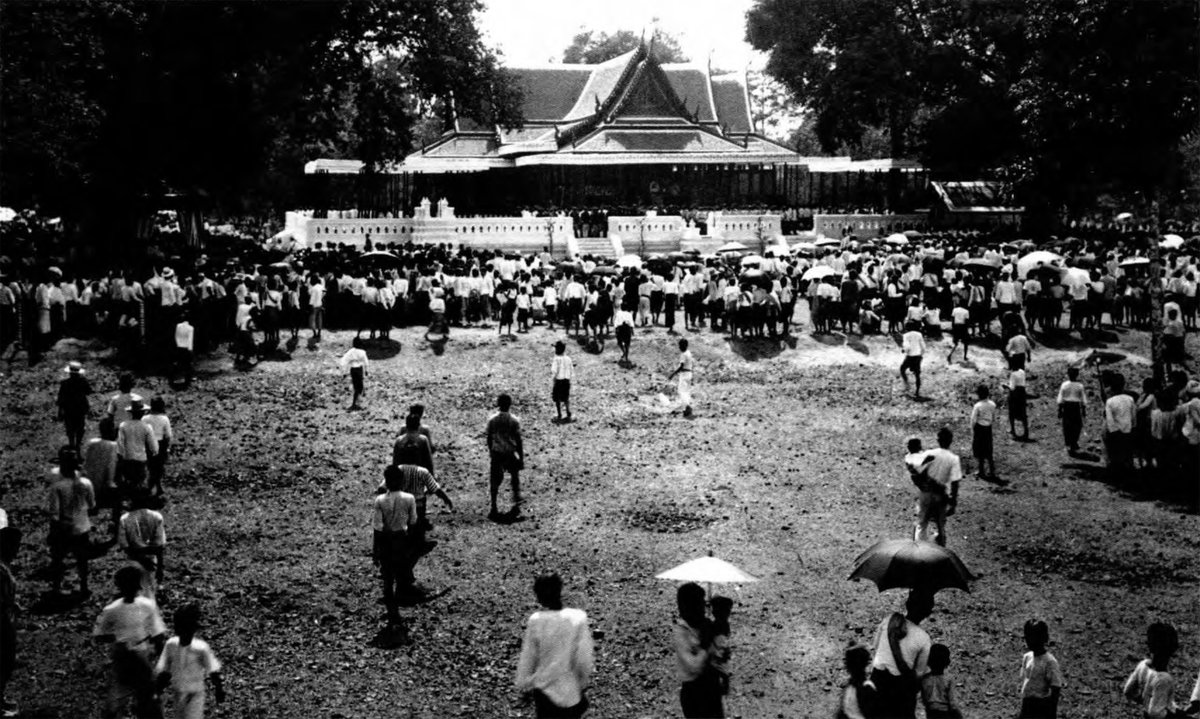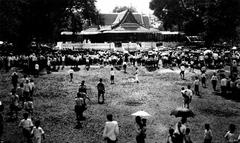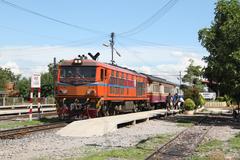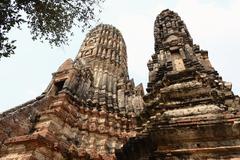
Chandra Kasem Palace Visiting Hours, Tickets, and Comprehensive Travel Guide
Date: 14/06/2025
Introduction: Chandra Kasem Palace and Its Historical Significance
Chandra Kasem Palace—also known as Wang Na or the Front Palace—stands as a testament to Thailand’s rich royal heritage in the heart of Phra Nakhon Si Ayutthaya. Established in 1577 under King Maha Thammarachathirat, the palace originally served as the residence of the Crown Prince, highlighting its crucial role in the political and dynastic stability of the Ayutthaya Kingdom. Strategically situated on the northeastern tip of Ayutthaya Island along the Pa Sak River, the palace offered both security and panoramic views of important waterways. Its architecture blends traditional Thai elements with European influences, reflecting Ayutthaya’s historical role as a vibrant trading center in Southeast Asia (thai2siam.com; thailandtoday51.wordpress.com).
After enduring destruction during the Burmese invasion in 1767, the palace was restored in the mid-19th century by King Rama IV, who added an observatory tower as a symbol of the kingdom’s openness to scientific advancement (patricklepetit.jalbum.net). Today, the site operates as the Chantharakasem National Museum, exhibiting royal regalia, Buddhist sculptures, historical documents, and personal effects of King Mongkut (Rama IV), offering immersive insights into Ayutthaya’s royal court life and architectural evolution (Holidify; Thailand.go.th).
Whether you are passionate about history, architecture, or culture, a visit to Chandra Kasem Palace is an essential experience for understanding Ayutthaya’s enduring legacy (backpackerboy.com; Renown Travel).
Historical Background and Royal Significance
Origins and Construction
Founded in 1577 by King Maha Thammarachathirat, Chandra Kasem Palace symbolized the importance of royal succession and stability (thai2siam.com). Located on Ayutthaya’s northeastern tip, its riverside setting provided natural defense and control over key waterways. The palace originally featured traditional Thai architecture, later incorporating European influences as Ayutthaya became a thriving trade hub (thailandtoday51.wordpress.com).
Role in the Ayutthaya Royal Court
As the residence of the Uparaja (Viceroy or Crown Prince), Chandra Kasem Palace played a pivotal role in governance and succession. Its proximity to the Grand Palace enabled efficient coordination between the king and the viceroy during periods of political turbulence (thai2siam.com).
Destruction and Restoration
The palace was destroyed during the 1767 Burmese invasion, leaving it in ruins for almost a century. Restoration was undertaken by King Rama IV in the 19th century, who rebuilt key structures and added an observatory tower for astronomical studies (patricklepetit.jalbum.net).
Transformation into a National Museum
In the 20th century, Chandra Kasem Palace was converted into a museum, preserving artifacts from the Ayutthaya period, including royal regalia, Buddha images, and personal items of King Rama IV (patricklepetit.jalbum.net).
Place in Ayutthaya’s Royal Complex
Chandra Kasem Palace was one of Ayutthaya’s three main royal residences, alongside the Grand Palace (Wang Luang) and the Rear Palace (Wang Lang), each with distinct roles for the royal family (thai2siam.com; thailandtoday51.wordpress.com).
UNESCO Recognition
In 1991, Ayutthaya Historical Park, including Chandra Kasem Palace, was designated a UNESCO World Heritage Site, affirming its global cultural significance (thailandtoday51.wordpress.com).
Visitor Information: Hours, Tickets, and Access
Opening Hours
- Chantharakasem National Museum: Wednesday–Sunday, 9:00 AM–4:00 PM. Closed Mondays, Tuesdays, and on Thai national holidays (Renown Travel).
Ticket Prices
- Foreign visitors: 100 THB per person.
- Thai nationals: Reduced rates or free entry on certain days.
Tickets are available at the entrance; check the official museum website for updates and online options.
Getting There
Located on Ayutthaya City Island along the Pa Sak River, the palace is accessible by bicycle, tuk-tuk, or on foot from other historical sites. From Bangkok, take a train from Hua Lamphong Station (1.5–2 hours) then a local tuk-tuk to the palace (planetware.com).
Accessibility
The palace complex offers wheelchair access to most exhibition areas, though some ruins and elevated structures may be difficult to reach. Contact the museum in advance for assistance.
Architectural Features
Layout and Historical Context
The palace’s grounds feature key structures such as the King’s private chambers, Throne Hall, and auxiliary pavilions. Fortified walls, a grand entrance, and riverside positioning provided both security and ceremonial grandeur (Holidify).
Architectural Styles
Chandra Kasem Palace combines traditional Thai elements—multi-tiered roofs, chofah finials, and intricate woodwork—with European touches such as stucco, glass windows, and neoclassical columns (Holidify).
Notable Structures
- Phiman Mongkut Pavilion: The King’s private residence.
- Throne Hall (Phra Thinang): Ceremonial center with gilded woodwork and historic murals.
- Watchtower: Offers panoramic views of Ayutthaya and the Pa Sak River.
Museum Collections
Key Exhibits
- Royal Regalia and Personal Effects: Crowns, ceremonial swords, and jewelry from King Mongkut (Rama IV).
- Historical Documents and Artifacts: Royal decrees, maps, and items salvaged after the Burmese invasion (Thailand.go.th).
- Buddhist Art and Sculpture: Buddha images, stucco reliefs, and ceremonial items from local temples (Journey in Thailand).
- Palace Furnishings and Decorative Arts: Lacquered cabinets, inlaid screens, and silk textiles reflecting Thai, Chinese, and European influences.
- Weapons and Military Artifacts: Swords, armor, and relics emphasizing Ayutthaya’s martial traditions.
Special Programs
Rotating exhibitions, guided tours, and educational workshops are available to enhance the visitor experience (Holidify).
Facilities and Visitor Amenities
- Wheelchair-friendly pathways and bilingual signage.
- Restrooms, shaded rest areas, and kiosks for water and refreshments.
- Souvenir shops near the entrance.
Photography Guidelines
Photography is allowed in most outdoor and indoor areas, but flash and tripods are restricted in some galleries to protect artifacts. Top spots include the Throne Hall, Phiman Mongkut Pavilion, and the watchtower for sweeping city views.
Nearby Attractions
- Wat Phra Si Sanphet: Ayutthaya’s most sacred temple.
- Chao Sam Phraya National Museum: Home to treasures and artifacts from Ayutthaya’s history.
- Ayutthaya Historical Park: Explore iconic temple ruins like Wat Mahathat (planetware.com).
- Wat Chaiwatthanaram: A stunning riverside temple complex (thecrazytourist.com).
When to Visit
- Cool Season (Nov–Feb): Best weather and most comfortable for touring.
- Hot Season (Mar–May): Visit early morning or late afternoon.
- Rainy Season (Jun–Oct): Lush landscapes but prepare for showers.
Weekday mornings are less crowded. Always check for Thai public holidays and local events.
Cultural Etiquette
- Dress modestly: Cover shoulders and knees.
- Remove shoes before entering exhibition rooms.
- Do not touch artifacts or climb on ruins.
- Maintain quiet and respectful behavior.
- Use the Thai “wai” greeting and basic Thai phrases when interacting with staff or locals.
Frequently Asked Questions (FAQs)
Q1: What are the visiting hours of Chandra Kasem Palace?
A1: Wednesday–Sunday, 9:00 AM–4:00 PM. Closed Mondays, Tuesdays, and on Thai holidays.
Q2: How much does it cost to enter?
A2: 100 THB for foreign visitors; reduced rates for Thai nationals.
Q3: Is the palace wheelchair accessible?
A3: Most main areas are accessible. Some ruins and upper floors may be challenging.
Q4: Are guided tours available?
A4: Yes, in Thai and English, bookable on-site or in advance.
Q5: Can I take photos inside the museum?
A5: Generally yes, but no flash or tripods in certain galleries.
Q6: How do I get there from Bangkok?
A6: Train from Hua Lamphong Station (1.5–2 hours), then tuk-tuk or bicycle to the palace.
Final Tips for Visiting Chandra Kasem Palace
To maximize your visit:
- Arrive early to avoid crowds and heat.
- Carry cash, water, sunscreen, and a hat.
- Join a guided tour for richer historical context.
- Respect all posted rules and cultural customs.
- Combine your visit with other nearby sites for a full-day Ayutthaya experience.
For the latest information on hours, ticketing, and special events, consult the Official Ayutthaya Historical Park Website or download the Audiala app for personalized guides and updates.
Sources and Further Reading
- thai2siam.com
- thailandtoday51.wordpress.com
- patricklepetit.jalbum.net
- Holidify
- Thailand.go.th
- Renown Travel
- planetware.com
- backpackerboy.com
- thecrazytourist.com
- Clever Thai
- Vietnam Travel Group


